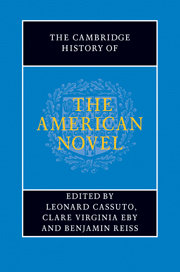Book contents
- Frontmatter
- General Introduction
- PART ONE INVENTING THE AMERICAN NOVEL
- PART TWO REALISM, PROTEST, ACCOMMODATION
- Introduction: realism, protest, accommodation
- 17 Realism and radicalism: the school of Howells
- 18 James, pragmatism, and the realist ideal
- 19 Theories of the American novel in the age of realism
- 20 The novel in postbellum print culture
- 21 Twain, class, and the Gilded Age
- 22 Dreiser and the city
- 23 Novels of civic protest
- 24 Novels of American business, industry, and consumerism
- 25 New Americans and the immigrant novel
- 26 Cather and the regional imagination
- 27 Wharton, marriage, and the New Woman
- 28 The postbellum race novel
- 29 The African American novel after Reconstruction
- 30 The rise of naturalism
- 31 Imagining the frontier
- 32 Imperialism, Orientalism, and empire
- 33 The hemispheric novel in the post-revolutionary era
- 34 The woman's novel beyond sentimentalism
- 35 Dime novels and the rise of mass-market genres
- 36 Readers and reading groups
- PART THREE MODERNISM AND BEYOND
- PART FOUR CONTEMPORARY FORMATIONS
- A selected bibliography
- Index
28 - The postbellum race novel
from PART TWO - REALISM, PROTEST, ACCOMMODATION
Published online by Cambridge University Press: 28 July 2011
- Frontmatter
- General Introduction
- PART ONE INVENTING THE AMERICAN NOVEL
- PART TWO REALISM, PROTEST, ACCOMMODATION
- Introduction: realism, protest, accommodation
- 17 Realism and radicalism: the school of Howells
- 18 James, pragmatism, and the realist ideal
- 19 Theories of the American novel in the age of realism
- 20 The novel in postbellum print culture
- 21 Twain, class, and the Gilded Age
- 22 Dreiser and the city
- 23 Novels of civic protest
- 24 Novels of American business, industry, and consumerism
- 25 New Americans and the immigrant novel
- 26 Cather and the regional imagination
- 27 Wharton, marriage, and the New Woman
- 28 The postbellum race novel
- 29 The African American novel after Reconstruction
- 30 The rise of naturalism
- 31 Imagining the frontier
- 32 Imperialism, Orientalism, and empire
- 33 The hemispheric novel in the post-revolutionary era
- 34 The woman's novel beyond sentimentalism
- 35 Dime novels and the rise of mass-market genres
- 36 Readers and reading groups
- PART THREE MODERNISM AND BEYOND
- PART FOUR CONTEMPORARY FORMATIONS
- A selected bibliography
- Index
Summary
Perhaps the most pressing matters to which students of the rather large body of so-called “race literature” produced during and immediately after the Civil War and Reconstruction must attend are simple questions of periodization and genre. In works ranging from Frances Harper's Iola Leroy (1892) to Mark Twain's Pudd'nhead Wilson (1894), and from Thomas Dixon's The Leopard's Spots (1902) to Sutton Griggs's The Hindered Hand (1905), one is confronted with what seems at times a shockingly discordant cacophony of form, theme, content, and style. “Old-fashioned” sentimental and gothic modes sit uncomfortably with modernist preoccupations with science and technology. The romance attempts valiantly, if quixotically, to regain ground long since lost to realism. And American writers of the late nineteenth and early twentieth centuries appear strangely preoccupied with race and racialism in a manner that many may find to be juvenile, if not downright embarrassing.
Indeed, the period, if one might call it that, seems so very unsettled as to make many otherwise rather generous scholars and critics throw up their hands in frustration. One may assume, with several notable exceptions, that the awkwardly named “postbellum race novel” is so very “undercooked” that we need pay little attention to it and then only as part of our ever so dull antiquarian duties.
- Type
- Chapter
- Information
- The Cambridge History of the American Novel , pp. 470 - 483Publisher: Cambridge University PressPrint publication year: 2011
- 1
- Cited by



